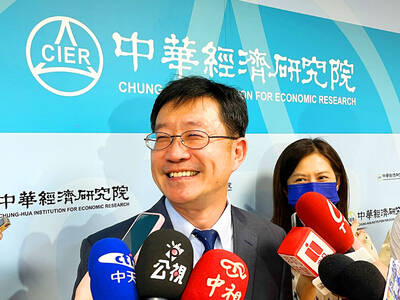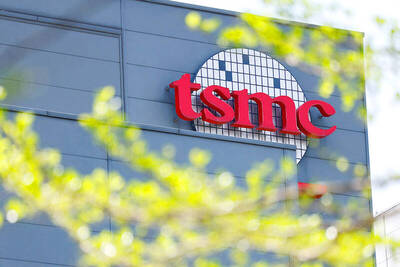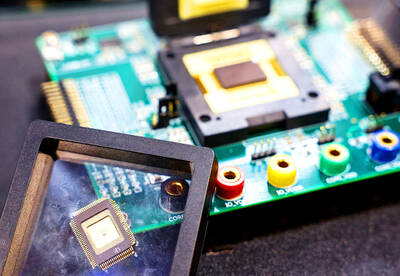An economic recession would not deter Intel Corp from continuously investing in new processor technologies and capacity expansion to support long-term growth, CEO Pat Gelsinger said on Tuesday.
The US chipmaker has adopted a more austere approach to investment in the near term amid an industry downcycle and macroeconomic uncertainty.
It has also become more “thoughtful” about operational investment, Gelsinger told reporters in a question-and-answer session following his keynote speech at this year’s Intel Innovation in San Jose, California.

Photo courtesy of Intel Corp via CNA
“When is the last time that a recession lasts for four or five years,” he asked. “Its impact on the industry may last several quarters like two, three or four quarters.”
However, it would take chipmakers 12 to 14 quarters to build a new fab, he said.
Developing a new processor architecture, or a core process technology requires multiple years of investments and efforts, he added.
“You cannot be driven by near-term financials,” Gelsinger said. “We are investing for the long term. That’s our strategy.”
Intel is spending on building process technology to earn technology leadership in four or five years, he said.
The company is investing in building fabs to ramp up those technologies across diverse segments from networking, graphics, automotive to data center businesses, he said.
Intel is helping build more globally balanced and resilient semiconductor supply chains to help meet growing demand for advanced semiconductors worldwide through the company’s IDM2.0 strategy, he said.
At the heart of its course is Moore’s Law, he said.
Moore’s Law is alive and well, he said, refuting Nvidia CEO Jensen Huang’s (黃仁勳) claim last week that Moore’s Law “is dead.”
He attributed breakthroughs in lithography and core of semiconductor manufacturing with advanced packaging technologies to the assertion.
Intel is on schedule, or even ahead of its schedule in developing five nodes in four years, Gelsinger said.
Normally, it takes two years to develop a node based on the law, he added.
“We will not rest until the periodic table is exhausted. We will continue to be the stewards of Moore’s Law into the future,” he said.
Intel expects to deliver its first 18A test chip by the end of the year, he said.
Intel’s 18A process technology is equivalent to the 2-nanometer technology developed by Taiwan Semiconductor Manufacturing Co (TSMC, 台積電). TSMC plans to start volume production of 2-nanometer chips in 2025.
As part of Intel’s IDM2.0 strategy, it is building more new capacity, including factories in Arizona and Ohio.
The chipmaker is also working on new capacity expansion projects in Israel, Ireland and Malaysia, it said.
Asked whether US control over chip exports to China would affect Intel’s chip design, or its IDM2.0 strategy, Gelsinger said there would be no change.
He said that oil reserves have defined geopolitics for the past five decades, but fabs and technology supply chains would be more important in the next five decades.
The chipmaker unveiled its latest-generation, 13th Gen Core i9-13900k processor for desktop computers, the world’s fastest desktop processor. The 13th Gen Intel Core family includes six new unlocked desktop processors with up to 24 cores and 32 threads and clock speeds of up to 5.8GHz for the best gaming, streaming and recording experience, it said.
With the new desktop processor and upcoming notebook processor, Intel believes overall PC shipments would return to growth next year, after a forecast decline this year, Sam Gao (高嵩), Intel vice president of Intel’s desktop processor business, told reporters in Taipei yesterday.
High-end gaming desktop and those designed for creators would be the major drivers, Gao said.

WEAKER ACTIVITY: The sharpest deterioration was seen in the electronics and optical components sector, with the production index falling 13.2 points to 44.5 Taiwan’s manufacturing sector last month contracted for a second consecutive month, with the purchasing managers’ index (PMI) slipping to 48, reflecting ongoing caution over trade uncertainties, the Chung-Hua Institution for Economic Research (CIER, 中華經濟研究院) said yesterday. The decline reflects growing caution among companies amid uncertainty surrounding US tariffs, semiconductor duties and automotive import levies, and it is also likely linked to fading front-loading activity, CIER president Lien Hsien-ming (連賢明) said. “Some clients have started shifting orders to Southeast Asian countries where tariff regimes are already clear,” Lien told a news conference. Firms across the supply chain are also lowering stock levels to mitigate

IN THE AIR: While most companies said they were committed to North American operations, some added that production and costs would depend on the outcome of a US trade probe Leading local contract electronics makers Wistron Corp (緯創), Quanta Computer Inc (廣達), Inventec Corp (英業達) and Compal Electronics Inc (仁寶) are to maintain their North American expansion plans, despite Washington’s 20 percent tariff on Taiwanese goods. Wistron said it has long maintained a presence in the US, while distributing production across Taiwan, North America, Southeast Asia and Europe. The company is in talks with customers to align capacity with their site preferences, a company official told the Taipei Times by telephone on Friday. The company is still in talks with clients over who would bear the tariff costs, with the outcome pending further

Six Taiwanese companies, including contract chipmaker Taiwan Semiconductor Manufacturing Co (TSMC, 台積電), made the 2025 Fortune Global 500 list of the world’s largest firms by revenue. In a report published by New York-based Fortune magazine on Tuesday, Hon Hai Precision Industry Co (鴻海精密), also known as Foxconn Technology Group (富士康科技集團), ranked highest among Taiwanese firms, placing 28th with revenue of US$213.69 billion. Up 60 spots from last year, TSMC rose to No. 126 with US$90.16 billion in revenue, followed by Quanta Computer Inc (廣達) at 348th, Pegatron Corp (和碩) at 461st, CPC Corp, Taiwan (台灣中油) at 494th and Wistron Corp (緯創) at

NEGOTIATIONS: Semiconductors play an outsized role in Taiwan’s industrial and economic development and are a major driver of the Taiwan-US trade imbalance With US President Donald Trump threatening to impose tariffs on semiconductors, Taiwan is expected to face a significant challenge, as information and communications technology (ICT) products account for more than 70 percent of its exports to the US, Chung-Hua Institution for Economic Research (CIER, 中華經濟研究院) president Lien Hsien-ming (連賢明) said on Friday. Compared with other countries, semiconductors play a disproportionately large role in Taiwan’s industrial and economic development, Lien said. As the sixth-largest contributor to the US trade deficit, Taiwan recorded a US$73.9 billion trade surplus with the US last year — up from US$47.8 billion in 2023 — driven by strong